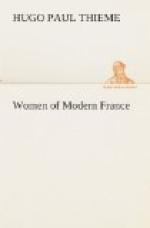After the death of Mme. de Tencin and that of Mme. de Chatelet, who had received many of the celebrities of the time, there remained but two distinguished, purely literary and philosophical salons open in Paris. By right of precedence, the betes should have gone over to the salon of Mme. du Deffand, as she had been established some years when Mme. Geoffrin began to receive at her residence, which gained its first renown through the exquisite dinners served there. But the betes all flocked to the salon bourgeois, and consequently a more brilliant gathering never assembled in a salon; here sat, enjoying the liberal hospitalities, Fontenelle, Montesquieu, Mairan, Marmontel, Helvetius, Diderot, D’Alembert, Thomas, D’Holbach, Hume, Morellet, Mlle. de Lespinasse, the Marquis de Duras, Comtesses d’Egmont and de Brionne. Here, conversation—which, in the eighteenth century, was not only a discussion or a dissertation, but an art—reached its highest development; the members did not need to be eloquent, to expatiate upon some theory or science; the conversation moved about the members, and they had to be a part of it.
Mme. Geoffrin was born in Paris in 1699, and was the daughter of M. Rodet, valet de chambre of the dauphiness, Duchesse de Bourgogne, mother of Louis XV. When barely fifteen she was married to the wealthy M. Geoffrin, the so-called founder of the celebrated Manufacture des Glaces de Gobelins. Through his wealth and his associations with people of nobility who bought his ware, she was soon encouraged in her desire to entertain the nobility; and her esprit, tact, intelligence, and admirable taste in dress were all effective in bringing about the desired results.
Her career was one of continual successes. When she opened her salon, in 1741, she instituted the custom of receiving her friends at table, not only men of letters, but artists, architects, builders, painters, sculptors, all men of genius and prominence. Monday was the day reserved for artists exclusively; Marmontel, who lived with Mme. Geoffrin for ten years “as her tenant,” and the indispensable Abbe Morellet were the exceptions who might be present upon that day. From the very beginning she formed the habit of permitting conversation to go just so far, then cutting it off with her famous: Voil qui est bien!
Her husband was the maitre d’hotel, of whom many interesting anecdotes are told; the best and one that illustrates well the appreciation of individuals in those days is the following, which is so admirably told by Lady Jackson that we quote from her: “For some years, there sat at the bottom of Mme. Geoffrin’s dinner and supper table a dignified-looking, white-haired old gentleman, bland in manner, but very modest and retiring, speaking only when spoken to, but looking very happy when the guests seemed to enjoy the good cheer set before them.




